External links
- The short film What Makes a Battle is available for free viewing and download at the Internet Archive .
| What Makes a Battle | |
|---|---|
| Produced by | US Army Pictorial Service |
Release date | 1944 |
| Country | United States |
| Language | English |
What Makes a Battle was a propaganda short produced by the US Army Pictorial Service in 1944. It documents the taking of the Marshall Islands while also encouraging increased war production.
The film opens with the narrator asking "What makes a battle?" while the camera is focusing on shipments of industrial transports, "This is what it takes to make a battle." This statement sets up the dual nature of the entire film. War supplies are pouring in from every part of the country, from every type of American "Republican and Democrat, white and colored." Industrial production is the backbone of war, according to the film, if it is destroyed, not made with quality, or not replaced in time, the battle cannot happen.
Then the film abruptly changes direction, and presents a summary of the American battle plan for taking the Marshalls, how the outer islands were bombed to fool the enemy, and how a sneak attack was planned against the inner islands. But this couldn't happen until all the supplies were ready. When the invasion does begin there is fierce fighting on the main islands. "The German would have surrendered, but not the Jap...Out of a garrison of 6000, 230 surrender." Much time is spent on the Japanese POWs, and the film goes to great lengths to show how well they are treated, especially in comparison to how the Japanese treated their POWs.
Emphasis then turns again to materiel. Showing all the destroyed planes, artillery, and ammunition, all needing to be replaced by the American workforce. But at the very end, images of the dead and wounded American soldiers are shown. The narrator assures us they will never be forgotten.

Why We Fight is a series of seven propaganda films produced by the US Department of War from 1942 to 1945, during World War II. It was originally written for American soldiers to help them understand why the United States was involved in the war, but US President Franklin Roosevelt ordered distribution for public viewing.

The Bataan Death March was the forcible transfer by the Imperial Japanese Army of 75,000 American and Filipino prisoners of war (POW) from the municipalities of Bagac and Mariveles on the Bataan Peninsula to Camp O'Donnell via San Fernando.

So Proudly We Hail! is a 1943 American war film directed and produced by Mark Sandrich and starring Claudette Colbert, Paulette Goddard – who was nominated for an Academy Award for Best Supporting Actress for her performance – and Veronica Lake. Also featuring George Reeves, it was produced and released by Paramount Pictures.
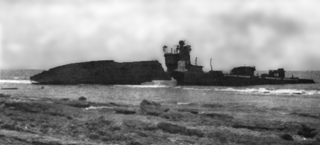
The Battle of Wake Island was a battle of the Pacific campaign of World War II, fought on Wake Island. The assault began simultaneously with the attack on Pearl Harbor naval and air bases in Hawaii on the morning of 8 December 1941, and ended on 23 December, with the surrender of American forces to the Empire of Japan. It was fought on and around the atoll formed by Wake Island and its minor islets of Peale and Wilkes Islands by the air, land, and naval forces of the Japanese Empire against those of the United States, with Marines playing a prominent role on both sides.
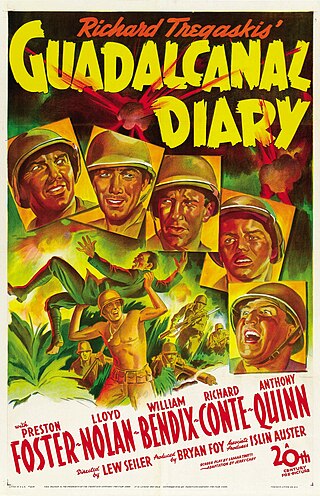
Guadalcanal Diary is a 1943 World War II war film directed by Lewis Seiler, featuring Preston Foster, Lloyd Nolan, William Bendix, Richard Conte, Anthony Quinn and the film debut of Richard Jaeckel. It is based on the book of the same name by Richard Tregaskis.
World War II officially ended in Asia on September 2, 1945, with the surrender of Japan on the USS Missouri. Before that, the United States dropped two atomic bombs on Japan, and the Soviet Union declared war on Japan, causing Emperor Hirohito to announce the acceptance of the Potsdam Declaration on August 15, 1945, which would eventually lead to the surrender ceremony on September 2.

The term "home front" covers the activities of the civilians in a nation at war. World War II was a total war; homeland military production became vital to both the Allied and Axis powers. Life on the home front during World War II was a significant part of the war effort for all participants and had a major impact on the outcome of the war. Governments became involved with new issues such as rationing, manpower allocation, home defense, evacuation in the face of air raids, and response to occupation by an enemy power. The morale and psychology of the people responded to leadership and propaganda. Typically women were mobilized to an unprecedented degree.
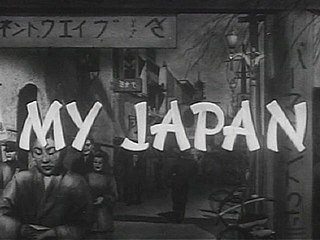
My Japan is a 1945 American anti-Japanese propaganda short film produced to spur sale of American war bonds. The film takes the form of a mock travelogue of Japan, presented by an impersonated Japanese narrator.
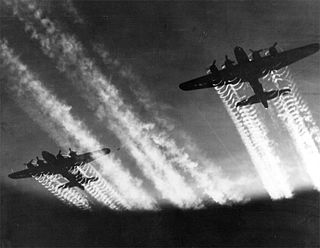
The military history of the United States during World War II covers the nation's role as one of the major Allies in their victory over the Axis Powers. The United States is generally considered to have entered the conflict with the 7 December 1941 surprise attack on Pearl Harbor by the Empire of Japan and exited it with the 2 September 1945 surrender of Japan. During the first two years of World War II, the US maintained formal neutrality, which was officially announced in the Quarantine Speech delivered by US President Franklin D. Roosevelt in 1937. While officially neutral, the US supplied Britain, the Soviet Union, and China with war materiel through the Lend-Lease Act signed into law on 11 March 1941, and deployed the US military to replace the British forces stationed in Iceland. Following the 4 September 1941 Greer incident involving a German submarine, Roosevelt publicly confirmed a "shoot on sight" order on 11 September, effectively declaring naval war on Germany and Italy in the Battle of the Atlantic. In the Pacific Theater, there was unofficial early US combat activity such as the Flying Tigers.
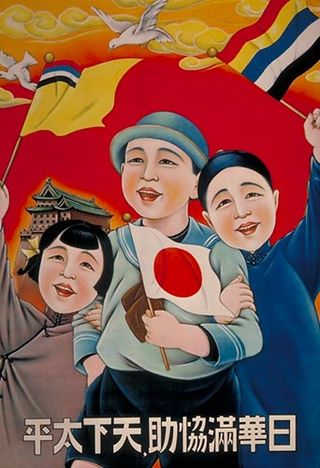
Japanese propaganda in the period just before and during World War II, was designed to assist the regime in governing during that time. Many of its elements were continuous with pre-war themes of Shōwa statism, including the principles of kokutai, hakkō ichiu, and bushido. New forms of propaganda were developed to persuade occupied countries of the benefits of the Greater Asia Co-Prosperity Sphere, to undermine American troops' morale, to counteract claims of Japanese atrocities, and to present the war to the Japanese people as victorious. It started with the Second Sino-Japanese War, which merged into World War II. It used a large variety of media to send its messages.

The Battle of Midway is a 1942 American short documentary film directed by John Ford. It is a montage of color footage of the Battle of Midway with voice overs of various narrators, including Johnny Governali, Donald Crisp, Henry Fonda, and Jane Darwell.
Know Your Enemy: Japan is an American World War II propaganda film about the war in the Pacific directed by Frank Capra, with additional direction by experimental documentary filmmaker Joris Ivens. The film, which was commissioned by the U.S. War Department, sought to educate American soldiers about Japan, its people, society and history, and its totalitarian militaristic government. However, the film never realized its full purpose because its completion was delayed by disputes between Hollywood and Washington, and the abrupt end of the Pacific War soon after the film's release in August 1945. The film's first public screening was in 1977 as part of a PBS special.
The Price of Rendova is a 1944 propaganda film created by the US Army Signal Corps. It documents the Landings on Rendova and Munda in the Solomon Islands.

December 7th is a 1943 propaganda documentary film produced by the US Navy and directed by John Ford and Gregg Toland, about the December 7, 1941 attack on Pearl Harbor, the event which sparked the Pacific War and American involvement in World War II. Toland was also the film's cinematographer. The original version of this film, with a running time of 82 minutes, was not released but was retained by the National Archives. An edited version of 32 minutes length, which removed a long introductory segment and a shorter epilogue, was given limited release to specific audiences but won the Academy Award for Best Documentary in 1944. This is the only film Toland ever worked on for which he received a director credit.
Return to Guam is a 1944 short propaganda film produced by the US Navy about the taking and recapture of the island of Guam.
The Crime of Korea was a 1950 propaganda film produced by the US Army Signal Corps mainly concerning the war crimes committed by the North Koreans.

Batu Lintang camp at Kuching, Sarawak on the island of Borneo was a Japanese-run internment camp during the Second World War. It was unusual in that it housed both Allied prisoners of war (POWs) and civilian internees. The camp, which operated from March 1942 until the liberation of the camp in September 1945, was housed in buildings that were originally British Indian Army barracks. The original area was extended by the Japanese, until it covered about 50 acres. The camp population fluctuated, due to movement of prisoners between camps in Borneo, and as a result of the deaths of the prisoners. It had a maximum population of some 3,000 prisoners.
Days of Infamy is a two-novel alternate history of the initial stages of the Pacific War by Harry Turtledove.

During World War II, it was estimated that between 35,000 and 50,000 members of the Imperial Japanese Armed Forces surrendered to Allied servicemembers prior to the end of World War II in Asia in August 1945. Also, Soviet troops seized and imprisoned more than half a million Japanese troops and civilians in China and other places. The number of Japanese soldiers, sailors, marines, and airmen who surrendered was limited by the Japanese military indoctrinating its personnel to fight to the death, Allied combat personnel often being unwilling to take prisoners, and many Japanese soldiers believing that those who surrendered would be killed by their captors.
World War II changed the possibilities for animation. Prior to the war, animation was mostly seen as a form of family entertainment. The attack on Pearl Harbor was a turning point in its utility. On December 8, 1941, the United States Army began working with Walt Disney at his studio, stationing Military personnel there for the duration of the war. The Army and Disney set about making various types of films for several different audiences. Most films meant for the public included some type of propaganda, while films for the troops included training and education about a given topic.